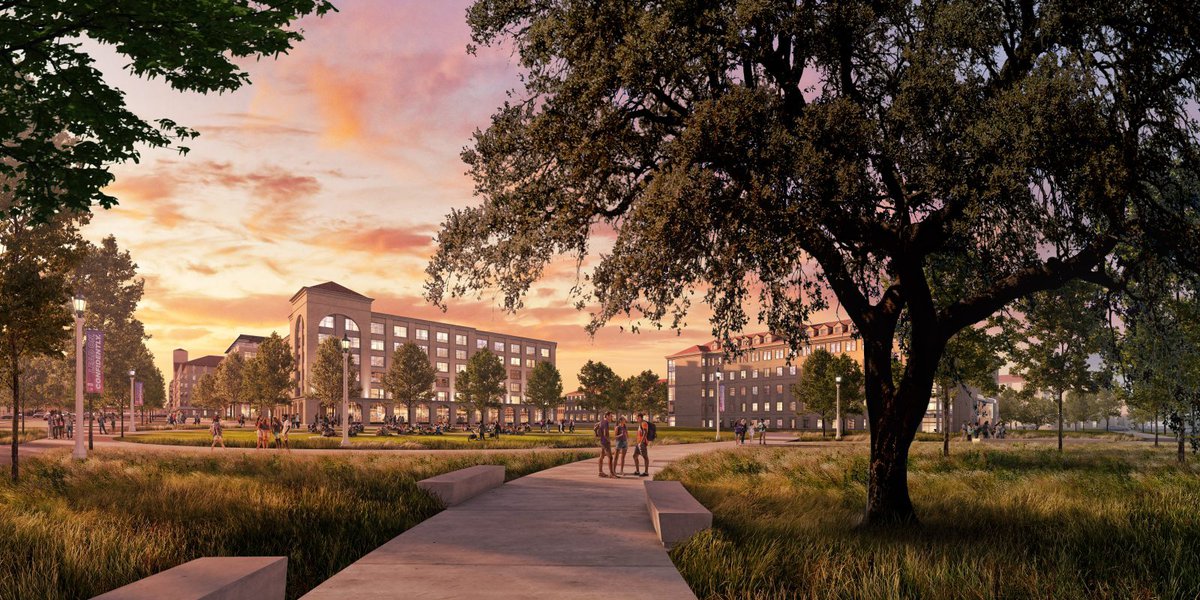The east side of TCU’s campus has always felt like a bit of a frontier — an in-between zone where dorm life gives way to traffic snarls, chain restaurants, and one stubbornly flood-prone stretch of road. A project from the university’s planning office aims to transform that edge into an inviting entryway — reshaping how students, neighbors, and even zoo visitors experience Fort Worth’s most recognizable private university.
TCU’s 2024 Campus Master Plan doesn’t just tweak a few sidewalks or add a tree or two. It proposes a full-scale transformation — a network of shaded pedestrian corridors, green spaces designed to double as stormwater retention zones, and — most notably — a clear path from campus to the Trinity River trail system less than a mile away.
“Right now, we have a very walkable campus, but that falls apart at its edges,” Jason Soileau, TCU’s associate vice chancellor of planning, design and construction told TCU News .
“This is one of the seven big ideas behind our master plan. A green network will add more open spaces, known to enhance mental well-being and promote physical fitness and collaboration. Simultaneously, this will give us an opportunity to address stormwater challenges.”
That issue is no small thing. Over the past decade, heavy rains have repeatedly overwhelmed the east side of campus — turning sidewalks into creeks and crosswalks into hazards. Soileau’s team is working with the City of Fort Worth on a series of solutions that go well beyond drainage pipes. Two blocks of university- and Brite Divinity-owned property near Forest Park Boulevard and McCart Avenue will be converted into landscaped, floodable parkland — designed for pickup soccer games on most days, and engineered to absorb excess stormwater on the worst ones.
But this isn’t just a flood fix dressed up with a few benches. TCU’s long-term vision is a campus that works as well on foot as it does on paper. From Berry Street to Bellaire Drive, circulation corridors will be widened and shaded. Bowie Street will gain bike lanes and stormwater features. And the university’s current east-west pedestrian spine — already a well-traveled route for students between class and residence halls — will be extended in both directions, forming a continuous loop that ties together old and new.
In short, the plan puts people first — walking, biking, studying outdoors, gathering under trees. It leans into the idea that a great college experience isn’t confined to classrooms or stadiums — it’s in the moments between them.
“We’re being very intentional about how and where the green spaces will be to make for the most pleasant campus experience we can,” Soileau said. “It’s all very achievable and what people are most excited about.”
Berry Street — long a utilitarian strip of student-focused commerce — is poised for its own glow-up. The plan imagines a greener, more vibrant corridor, with shops, restaurants, and apartment-style housing seamlessly integrated with campus life. A large, landscaped gateway would offer both a new visual identity for the east side of campus and a flexible venue for outdoor events.
The initiative also responds to growth. As TCU’s student population continues to rise, so does demand for residence halls, classrooms, and research space. The Master Plan anticipates that too — layering in new academic buildings, athletic facilities, and living quarters that aim to match the university’s national ambitions.
But for all its architectural renderings and infrastructure goals, the heart of the plan is something simpler — make it easier for people to be outside, together.
It’s not just about aesthetics, either. Study after study has shown that students who spend more time outdoors — especially in intentional, welcoming spaces — report higher levels of well-being and stronger community connection.
And then there’s the crown jewel: the Trinity River. Just a short walk north of campus, it remains surprisingly disconnected from the university it practically borders. No sidewalk links the two. No bike lane beckons students toward the water.
That’s changing. Soileau says a link to the trail system is both realistic and popular.
“We’re being very intentional about how and where the green spaces will be to make for the most pleasant campus experience we can,” Soileau said. “It’s all very achievable and what people are most excited about.”
